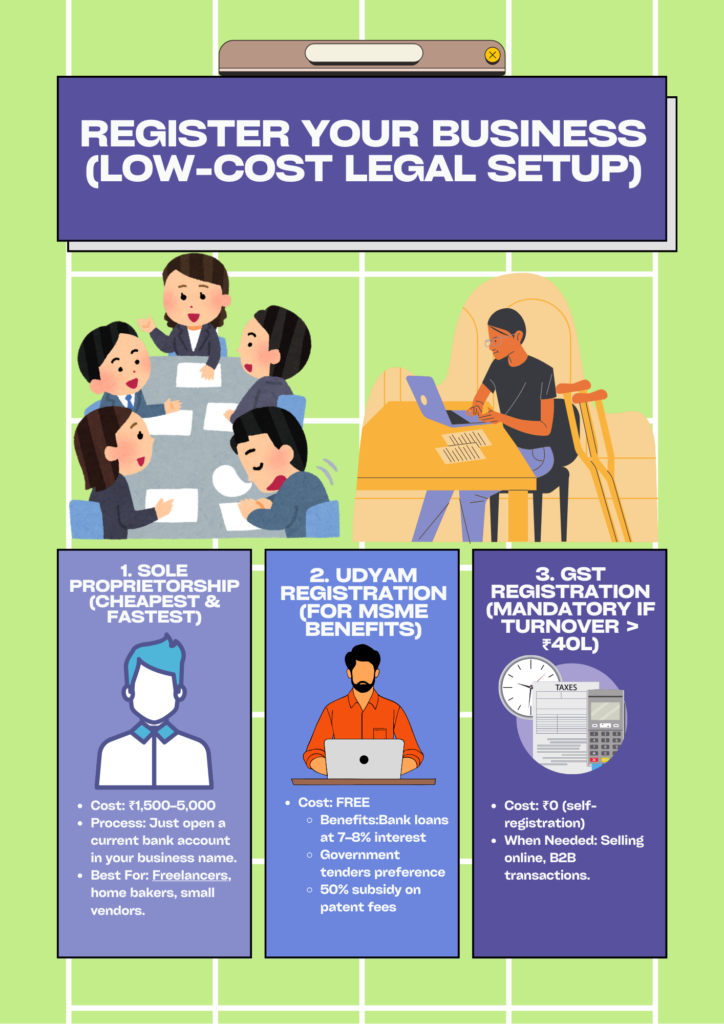Have you ever thought about launching your own business in India? With rapid technological progress and a booming economy, 2025 presents an ideal landscape for entrepreneurs. But with numerous industries expanding, which ones offer the highest potential?
Starting a business in India has never been easier, thanks to digital tools, government schemes, and a booming startup culture. Whether you want to escape the 9-5 grind or create an additional income stream, you can launch a profitable small business in 2025 with as little as ₹10,000–50,000.
This step-by-step guide will walk you through low-investment business ideas, registration processes, funding options, and growth strategies tailored for Indian entrepreneurs.
Let’s turn your business dream into reality!
Why Start a Small Business in 2025?
- Digital Advancements: The widespread adoption of digital payment systems like UPI, coupled with the proliferation of social media and e-commerce platforms, has simplified customer outreach and transaction processes.
2. Government Support: Initiatives such as the Startup India Scheme, Pradhan Mantri Mudra Yojana (PMMY), and the Credit Guarantee Fund Trust for Micro and Small Enterprises (CGTMSE) provide financial assistance and resources to budding entrepreneurs.
3. Cost-Effective Opportunities: Numerous business models now allow operations from home or through digital platforms, significantly reducing overhead costs.
Step 1: Choose the Right Business Idea (Low Investment, High Profit)
Here are some promising small business ideas in India for 2025 that require an investment of under ₹50,000:
- Freelance Services (Investment: ₹0–10,000)
- Examples: Content writing, graphic design, social media management.
- Platforms: Fiverr, Upwork, Urban Company.
- Earnings Potential: ₹20,000–1,00,000/month.
Also Read: How to File ITR for Freelancers in India: Step-by-Step Guide
- Home-Based Food Business (Investment: ₹10,000–30,000)
- Examples: Home bakery, meal prep services, production of pickles or jams.
- Legal Requirement: FSSAI Basic License.
- Selling Platforms: WhatsApp, Swiggy Instamart, Zomato Hyperpure.
- Dropshipping (Investment: ₹5,000–20,000)
- How It Works: Sell products online without maintaining inventory.
- Popular Niches: Customized gifts, eco-friendly products.
- Platforms: Shopify, WooCommerce, Meesho.
- Online Tutoring (Investment: ₹0–10,000)
- Subjects in Demand: Coding (Scratch/Python), CBSE/NEET coaching, Spoken English.
- Platforms: YouTube, Teachmint, Udemy.
- Digital Printing & Merchandise (Investment: ₹20,000–50,000)
- Examples: T-shirt printing, custom mugs, wedding invitations.
- Equipment Needed: Basic printer and design software like Canva.
Additional Low-Investment Business Ideas to Consider
- Instagram Thrift Store: Source affordable items and resell them at a markup through Instagram.
- AI-Based Resume Writing: Utilize AI tools like ChatGPT and design platforms like Canva to offer professional resume writing services.
- Pet Grooming Services: Provide grooming services for pets, catering to the growing pet ownership market.
- Vehicle Cleaning Services: Offer car and bike washing services, which require minimal equipment and can be operated from various locations.
- Podcast Production Studio: Assist local influencers and businesses in recording and editing podcasts, tapping into the growing podcasting trend.
Step 2: Register Your Business (Low-Cost Legal Setup)

1. Sole Proprietorship (Cheapest & Fastest)
- Cost: ₹1,500–5,000
- Process: Just open a current bank account in your business name.
- Best For: Freelancers, home bakers, small vendors.
2. Udyam Registration (For MSME Benefits)
- Cost: FREE
- Benefits:
- Bank loans at 7–8% interest
- Government tenders preference
- 50% subsidy on patent fees
3. GST Registration (Mandatory if turnover > ₹40L)
- Cost: ₹0 (self-registration)
- When Needed: Selling online, B2B transactions.
Step 3: Securing Funding Through Government Schemes
- Pradhan Mantri Employment Generation Programme (PMEGP)
- Eligibility: Individuals aged 18 and above.
- Financial Assistance: Subsidy up to ₹25 lakh for manufacturing units and ₹10 lakh for service units.
- Margin Money: Entrepreneurs contribute 5–10% of the project cost.
- Pradhan Mantri Mudra Yojana (PMMY)
- Loan Categories:
- Shishu: Loans up to ₹50,000 for startups.
- Kishor: Loans ranging from ₹50,000 to ₹5 lakh for expanding businesses.
- Tarun: Loans between ₹5 lakh and ₹10 lakh for established enterprises.
- Loan Categories:
- Credit Guarantee Fund Trust for Micro and Small Enterprises (CGTMSE)
- Purpose: Provides collateral-free credit to micro and small enterprises.
- Coverage: Up to 85% of the sanctioned loan amount, facilitating easier access to credit for entrepreneurs.
Step 4: Marketing Your Business Affordably
- Utilize Social Media Platforms
- Tools: WhatsApp Business, Instagram Reels.
- Strategy: Share engaging content showcasing your products or services, behind-the-scenes processes, and customer testimonials.
- Leverage Google My Business
- Benefit: Enhances visibility in local searches, making it easier for nearby customers to find your business.
- Implement Referral Programs
- Example: Offer discounts or incentives to customers who refer new clients to your business, fostering word-of-mouth marketing.
Step 5: Scaling Your Business from ₹50,000 to ₹5 Lakh per Month
- Automate Operations: Use tools like Khatabook for managing accounts and Shiprocket for streamlining deliveries.
- Introduce Subscription Models: Offer services or products on a subscription basis, such as monthly snack boxes or regular service packages, to ensure consistent revenue.
- Diversify Offerings: Expand your product or service range to include complementary items or services, enhancing customer value and increasing sales opportunities.
Final Checklist Before Launching Your Business
- Conduct Market Research: Test demand with a small pilot batch or survey to validate your business idea.
- Ensure Legal Compliance: Obtain necessary licenses and registrations, such as GST if applicable.
- Set Up Financial Systems: Open a dedicated business bank account to manage finances effectively.
- Initiate Marketing Efforts: Begin promoting your business ahead of the official launch to build anticipation and attract initial customers.
Frequently Asked Questions (FAQs) on Starting a Small Business in India
Q1: What are the best small business ideas under ₹50,000 in India?
Some of the most profitable options include freelancing, dropshipping, food businesses, online tutoring, and digital printing.
Q2: Do I need to register my business immediately?
While immediate registration is not mandatory, early registration (such as Udyam/MSME) provides access to government benefits and financial support.
Q3: What funding options are available for new businesses?
Entrepreneurs can apply for Mudra loans, PMEGP subsidies, and the Startup India Seed Fund, all of which provide low-interest financing or grants.
Q4: Can I start a business without a physical store?
Yes, online businesses such as freelancing, reselling, and food delivery services can operate without a storefront.
Q5: What are the legal requirements for starting a food business in India?
Obtaining an FSSAI License (₹2,000 per year) is necessary for selling food items.






Leave a Reply